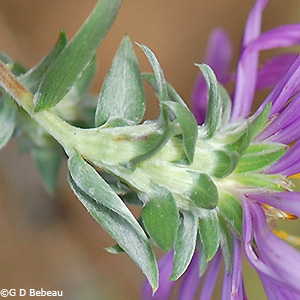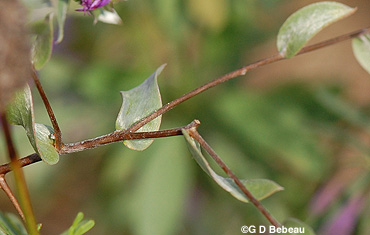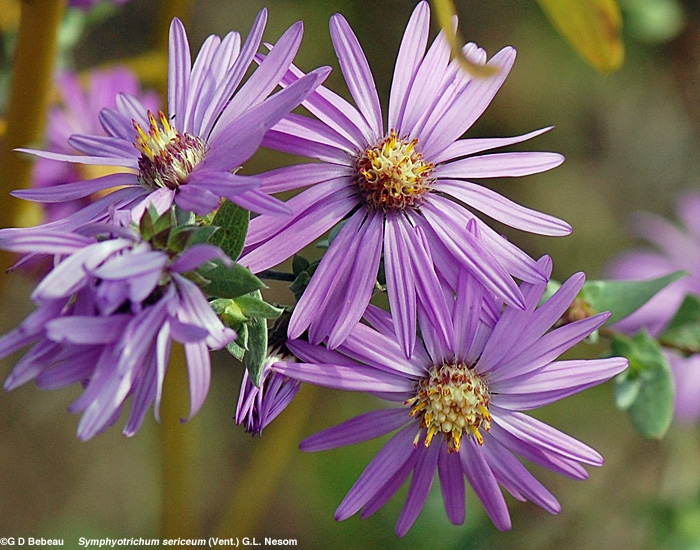The Friends of the Wildflower Garden, Inc.
Plants of the Eloise Butler Wildflower Garden
The oldest public wildflower garden in the United States

Common Name
Silky Aster (Western Silver Aster)
Scientific Name
Symphyotrichum sericeum (Vent.) G.L. Nesom
Plant Family
Aster (Asteraceae)
Garden Location
Upland
Prime Season
Late Summer to Autumn
Stems: Silky Aster is a low-growing native perennial aster that grows to two feet tall on wiry stems that usually sprawl. Stems are greenish when new but quickly turn to a more muted reddish brown color and are covered with fine hair above the base sections. The wiry structure of the stem that at times zigzags, tends to make the plant look like a tangled mess.
Leaves: The common name comes from the distinctive leaves which are pale greenish, silky and of a silvery tint, with smooth edges, covered with a fine coat of dense hair which enhances the silver effect. They are sessile (unstalked) and semi-clasping, oblong to linear-lanceolate (narrowly broadest in the lower half) in shape. Basal leaves, which are larger, will have dropped off by flowering time. Both basal and stem leaves have a sharp pointed tip.
The floral array is a small cluster of flower heads in panicle form at the end of a branching and usually arching stem.
Flowers: The flowers are quite wide for the size of the plant, being up to 1-1/4 inches across. The composite flowers have two types of florets. The outer ray florets number 15 to 30 and have lavender to pale blue (lilac) spreading rays. These are pistillate and fertile. They surround the central disc of 25 to 35 tubular, yellow, disc florets where the tubes have long deltate lobes. The disc floret corolla turns to a more reddish-purple color at maturity, typical of asters in this genus. Disc florets are bisexual, fertile, and open from the outside edge of the cluster to the center. These have 5 stamens with reddish anthers. Stamens tightly surround the style and both are exserted from the tube when the floret opens. On each flower stalk are some green leafy bracts which grade into 3 to 5 series of overlapping phyllaries that surround the flowerhead. These are ovate in shape with spade-like dark green pointed tips and a pale green mid-line. The tips are usually spreading to reflexed. Like the leaves, they have a fine silvery hair.
Seeds are a dry 7 to 10 nerved brownish cypsela, 2 to 3 mm long, that has a small tuft of whitish to tawny hair for wind dispersion. Seeds weigh about 26,000 to the ounce. Seeds require 60 days of cold stratification for germination.
Habitat: Silky Aster is an aster of sunny dry locations (dry-mesic to dry) such as where it is located in the Upland Garden. It must have well drained soil, and it handles drought and high alkalinity well. It grows from a short rhizome and fibrous roots which can form a woody caudex.
Names: Like most new world asters, Silky Aster has undergone a series of scientific name revisions. It was once Aster sericeus. All the new world asters, formerly in the genus Aster, have now been reclassified, most into the genus Symphyotrichum. The genus name is from the Greek symphysis, for 'junction', and 'trichos', for hair and, while obscure, it was first applied by Christian Gottfried Daniel Nees von Esenbeck in the 1800s in describing the type aster for the genus. The species name sericeum, means 'silky'. The author names for the plant classification are: First to classify was ‘Vent.’ which is for Étienne Pierre Ventenat (1757-1808), French botanist who published several works about plants in French gardens including the rare plants of Malmaison. French gardens grew many species imported from the New World. His work on this species was updated by ‘G. L. Nesom’ who is Guy L. Nesom (b. 1945) American botanist who has published papers on the nomenclature of asters.
Comparisons: The lilac color ray flowers may resemble the New England Aster but the small silky leaves are not confusing with another aster species in our area but further south, S. pratense, Barrens Silky Aster, is similar in shape and flower except the leaves and phyllaries are different.


Above: Stems are usually sprawling and the flowers are in small groups at the end of stems. Drawing from Britton, N.L., and A. Brown. 1913. An illustrated flora of the northern United States, Canada and the British Possessions. 3 vols. Charles Scribner's Sons, New York.
Below: The beautiful blooms of Silky Aster are large compared to the size of the plant and the size of the leaves. The corollas of the center disc florets turn reddish-purple at maturity.


Below: 1st photo - The disc florets open from the outside edge of the disc first. The corollas have long deltate shape lobes. 2nd photo - The leafy green bracts on the flower stalk grade into smaller phyllaries with green tips that spread outward with some reflexing, all with silky hair.


Below: The wiry stems tend to sprawl and are covered with fine hair as are the leaves which presents the "silvery" appearance. Leaves are sessile and partially clasping.


Below: The flowers have 15 to 30 lilac to pale blue fertile ray florets per flower head which surround the central disc of numerous disc florets. The floral array is a small cluster of flowers in open panicle form.

Notes: Silky Aster is not indigenous to the Garden area. Eloise Butler recorded introducing this plant to the Garden in 1907 from a source in Mahtomedi and again in 1908 from two sources - Mahtomedi and Indian Mounds in St. Paul. In 1914 some came from Columbia Heights, MN. In 1917 from Mahtomedi again and on Oct. 8, 1917, 51 plants from within Glenwood Park, more from Ft. Snelling in 1918 and more from there in 1920. After that the species was planted every year through 1932 except in 1924. The large and odd quantities noted in the log from Glenwood Park indicate that these may have been seedlings sourced from the Park Board Nursery which was located just across Glenwood Ave. from the Garden at Glenwood Lake. At that time the accepted botanical name was Aster sericeus. Martha Crone planted it in 1934, '36, '38, '44, and '45.
Silky Aster was listed on Martha Crone's 1951 inventory of plants in the Garden at that time. The plant is native to many counties in Minnesota except in the NE quadrant with scattered exceptions elsewhere. In North America it is found only in the Central Plains states of Ohio on the east and the Dakotas on the west and south to Texas. In Canada it is known from Manitoba and Ontario, where they are considered rare and endangered. There are twenty-four species just of Symphyotrichum listed by the DNR and the U of M Herbarium as being found in Minnesota, some with several subspecies.
Eloise Butler wrote about the asters in the Garden in her 1915 report to the Board of Park Commissioners. Of this species she said: "If I have any special favorite, it is Aster sericeus. The flowers are lilac tinted, a shade peculiar to themselves, and the contrast with the silky, pale foliage is altogether charming. It is abundant on the hillsides just outside of the garden and I have introduced it in large quantities." Much the same text was incorporated into an essay that was sent to The Gray Memorial Botanical Chapter, (Division D ) of the Agassiz Association for publication in the Chapter's circular. Text here.
Return to -- Site Plan/Archive Index --or-- List of Common Plant Names -- or -- List of Scientific Names -- or --Home Page - - - Back to top.
References: Plant characteristics are generally from sources 1A, 32, W2, W3, W7 & W8 plus others as specifically applied. Distribution principally from W1, W2 and 28C. Planting history generally from 1, 4 & 4a. Other sources by specific reference. See Reference List for details.
 Identification booklet for most of the flowering forbs and small flowering shrubs of the Eloise Butler Wildflower Garden. Details Here.
Identification booklet for most of the flowering forbs and small flowering shrubs of the Eloise Butler Wildflower Garden. Details Here.
©2015
Friends of the Wildflower Garden, Inc. Text and photos are by G. D. Bebeau unless otherwise credited. "www.friendsofeloisebutler.org"
040920